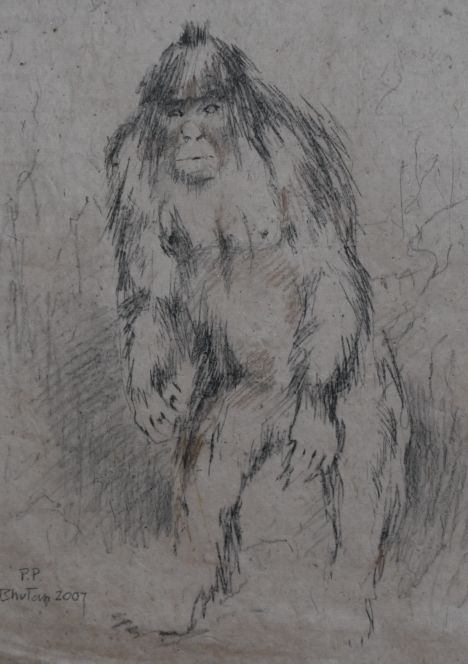Sir David Attenborough and the Yeti
Posted by: Loren Coleman on March 1st, 2009
Yeti evidence is ‘convincing’ says wildlife expert Sir David Attenborough
Sir David Attenborough believes there is ‘very convincing’ evidence that yetis exist.
Speaking on Friday Night With Jonathan Ross, the revered wildlife expert said: ‘I’m baffled by the Abominable Snowman – very convincing footprints have been found at 19,000ft.

‘No-one does that for a joke. I think it’s unanswered.’
The yeti is an ape-like creature said to inhabit the Himalayan region of Nepal and Tibet.
A photograph of a mysterious footprint, rumoured to be that of the yeti was taken in the Menlung Basin in the Himalayas in 1951.
A team of mountaineers travelled to the region on a reconnaissance mission before attempting to conquer Everest for the first time, a feat achieved two years later.
Eric Shipton recorded the footprint, and Tom Bourdillon, passing on the evidence to his friend Michael Davies, wrote: ‘Dear Mick, Here are the footprint photos: sorry for the delay. We came across them on a high pass on the Nepal-Tibet watershed during the 1951 Everest expedition.
‘They seemed to have come over a secondary pass at about 19,500 ft, down to 19,000 ft where we first saw them, and then went on down the glacier.’
In 1954, the Daily Mail reported the discovery of hair specimens from what was said to be the scalp of a yeti.
Professor Frederick Woods Jones, an expert in human and comparative anatomy, failed to reach a conclusion, but said the dark brown hair was not from a bear or an anthropoid (manlike) ape.

Yeti? The footprint spotted by Eric Shipton
Alleged sightings and debate has continued through the decades – but so far no-one has been able to produce a clear, definitive photograph of the world’s most elusive being.
Tibetan folklore has it that the yeti is nocturnal, whistles, and can kill with a single punch.
Investigators believe that at least two types of yeti exist: the dzu-teh (‘big thing’), which is 7ft-8ft tall, and the nich-teh, which is 5ft-6ft.

Fur blur: A recent sketch of the Yeti thought to be prowling around the Himalayas
Sir David also spoke about not being able to halt climate change.
He said: ‘We can never go back, there’s no doubt about that… it’s the speed at which we’re changing.
‘Before, it was thousands of years and now it’s decades… but we can slow down the rate at which we change.’Sarah Nelson
The Daily Mail
About Loren Coleman
Loren Coleman is one of the world’s leading cryptozoologists, some say “the” leading living cryptozoologist. Certainly, he is acknowledged as the current living American researcher and writer who has most popularized cryptozoology in the late 20th and early 21st centuries.
Starting his fieldwork and investigations in 1960, after traveling and trekking extensively in pursuit of cryptozoological mysteries, Coleman began writing to share his experiences in 1969. An honorary member of Ivan T. Sanderson’s Society for the Investigation of the Unexplained in the 1970s, Coleman has been bestowed with similar honorary memberships of the North Idaho College Cryptozoology Club in 1983, and in subsequent years, that of the British Columbia Scientific Cryptozoology Club, CryptoSafari International, and other international organizations. He was also a Life Member and Benefactor of the International Society of Cryptozoology (now-defunct).
Loren Coleman’s daily blog, as a member of the Cryptomundo Team, served as an ongoing avenue of communication for the ever-growing body of cryptozoo news from 2005 through 2013. He returned as an infrequent contributor beginning Halloween week of 2015.
Coleman is the founder in 2003, and current director of the International Cryptozoology Museum in Portland, Maine.










I wonder. Most primate species are sexually dimorphic, with males much larger, on average, than females. Maybe the size difference here can be accounted for not by two different species of yeti, but as the difference in size between males and females of the same species.
I’m 5′ 3½”, but one of my sons is 6′ 6″ & the other is 6′ 3″. Someone coming across my tracks in the snow, and then maybe coming across theirs sometime later in another place, might conclude that we were two species of different size.
We should keep Sir Attenborough’s statements on a lid, or Richard Dawkins will blow a fuse 😉
Kittenz: agreed.
Of course, on most continents where there is one kind of animal, there is usually another species of the same kind (monkey, ape, bear, deer, cat, canid, etc.) For one example, of course still theoretical, I’m not so sure that “juvenile” sasquatch (usually, from the reports I have read, seen alone) aren’t the American equivalent of the chimpanzee or gibbon – just a smaller ape. There could – once we confirm that there’s one in the first place – be two or more species of sasquatch. This is true of the other apes; why not this one?
For all the speculation about two or more different kinds, the reports of yeti seem to be as consistent, on as much of the range of the particulars, as for the sasquatch.
An AOL News poll has 75% of over 40,000 respondents saying the yeti either does or might exist.
Maybe with news like this, there’s hope yet for serious research to find out.
What? Schaller and Goodall aren’t “revered” enough? lol
Interesting opinion from Attenborough—that much is clear.
I have come to disagree with his evolutionist views but I’ve always respected and even admired Attenborough as a wildlife expert. His shows were always fascinating.
Red_Pill_Junkie: I don’t think Dawkins cares anyway. 🙂
There are few people I openly envy for their lives, but David Attenborough has got to be at the top of that list.
He’s been everywhere on the planet at least twice, has seen things with his own eyes from a few feet away that I’ll only ever view photos of, and has generally lived a scholar-adventurer’s lifestyle for the last 50 years. True class, and one guy that I’d give anything to have a few drinks with while talking nature.
If the evidence that has been collected in the past is convincing enough to intrigue Sir David, that’s good enough for me. Bring on the expeditions!
Sounds like an insomniac Joe Frazier…
Sir David’s TV series “The Living Planet” is a real cornerstone of my life. It’s the one that really made me sit up and realize that we humans need to better respect nature. It totally shaped my environmental beliefs.
Kittenz, DWA- Sexual dimorphism is something that I’ve often considered myself in not only Yeti, but with other alleged hairy hominids that have conflicting average sizes for reports as well (such as the Yowie of Australia). Some people say they must be jueveniles or another species, but I wonder if sexual dimorphism could possibly be at work.
It might not necessarily even be sexual dimorphism that causes these differences. In humans there is a wide range of differing sizes and builds even between members of the same sex. For instance, I am 6′ 3″ tall, but I have a friend, also male, who is much shorter than me and more slightly built. Same species, same sex, vastly differing body types. Human beings come in a mind boggling range of shapes and sizes, so it seems possible that the same could be true of Yeti, sasquatch, and other hairy hominids, even within the same species.
It is also possible that some of the more unique sightings of very small or truly huge (10 to 13 foot range) sasquatch sightings could be examples of the same genetic factors leading to dwarves or midgets, and conversely gigantism, in human individuals.
So although these are just speculative hypotheses, I think there are a wide range of possible factors, other than merely different species, that could lead to varying sizes or other differences in appearance in some reports such differing builds, coloration, posture, etc. I think in some cases, reports that mention small differences from the “norm” actually enhance the feeling that we are dealing with a real animal that exhibits individual variation.
DWA- I thought I would also comment on what you said about similar species on different continents.
A more accurate way to explain it would be not that similar species will necessarily be found on a continent, but rather that species will evolve to fulfill similar ecological niches in like habitats. Sometimes the species that fills a given niche will be a very successful animal that has spread far and wide, such as canids, ursids, or felids. Other times, unrelated animals will evolve in similar ways due to convergent evolution, such as the Thylacine evolving to look very much like canids (even though they are very different animals). Still other animals will evolve in unique ways to fill the same niche as a much different animal somewhere else. For instance, in New Zealand, many birds and insects have evolved to fill ecological roles normally filled by mammals elsewhere.
The point is that the niche within the habitat is what is important. Animals in North America do not necessarily have to look like or mirror their counterparts in Africa, and vice versa. For instance, there is nothing that says North America must have an animal that is a direct equivalent of a chimpanzee or ape. Although there might be such an animal, it is not a given.
m_m: Great stuff as usual.
“Human beings come in a mind boggling range of shapes and sizes, so it seems possible that the same could be true of Yeti, sasquatch, and other hairy hominids, even within the same species.”
It’s been theorized that sasquatch may have much less in the way of selective pressure operating to ensure size shape and build conformity than for other animals, hence a similarity to human variation. (Most animals with eyeshine have one distinguising color. A number of eyeshine colors are reported for sasquatch. For one example.)
“For instance, there is nothing that says North America must have an animal that is a direct equivalent of a chimpanzee or ape. Although there might be such an animal, it is not a given.”
That and everything else in those last two paragraphs is true. My intent is to address those Eugenie Scotts of the world who think that since gorillas are tropiical folivores, apes can’t be anything else. (And of course other apes are other things. Frugivores, insectivores, piscivores…porkivores? 😀 …omnivores. Known ones, that is.)
Things we see elsewhere – like multiple species of ape, monkey, prosimian, bear, canid, feline, etc. – are possibilities in the temperate zone just as in the tropics, the illustration being that most other kinds of animal have speciated to populate disparate niches.
It can’t be presumed that apes did in places where they’re not known yet.
But one can only argue in a very limited way from what one knows to what one does not.
DWA- Porkivores? lol 🙂
I agree, there is nothing in particular that says to me it’s impossible for there to be temperate zone apes, just as there could be northern ranging apes like a Yeti. Geographic isolation could lead to significant adaptations to these conditions.
There are monkeys [not “moneys” as written earlier] that have managed to adapt to cold, northern environments and even desert habitats. We just haven’t seen anything like that in apes yet.